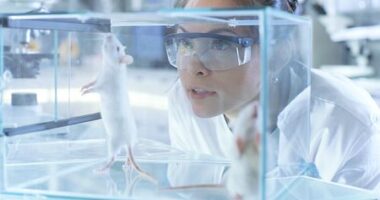Radiation Therapy for Childhood Leukemia Alters BMI Heritability, Study Finds

Adult survivors of childhood acute lymphoblastic leukemia (ALL), who are at high risk for obesity, exhibit alterations in genetic variants associated with body mass index (BMI) — a measure of body fat based on height and weight — following cranial radiation therapy (CRT), a study reports.
The findings also showed that the obesity risk among these patients, like with the general population, results from variations in multiple BMI-related genes.
The study, “Genetic variation in the body mass index of adult survivors of childhood acute lymphoblastic leukemia: A report from the Childhood Cancer Survivor Study and the St. Jude Lifetime Cohort,” was published in the journal Cancer.
ALL, a cancer affecting immune cells in the bone marrow, is the most common cancer diagnosed in children. Advances in treatment have improved the ALL prognosis, with more than 90% of children surviving to adulthood.
Notably, though, cranial radiation therapy has been associated with increased BMI in adult survivors, particularly women who receive CRT before age 4.
Mutations in the receptor for the hunger-suppressing protein leptin affect BMI in female ALL survivors, particularly those who received CRT. Such findings suggest that genetic factors may play a role in the obesity risk among every ALL survivor, as it does in the general adult population.
Now, researchers at Baylor College of Medicine and their collaborators sought to determine the association between genetic variation and adult BMI. The team analyzed genomic data of adult survivors of childhood ALL collected from the Childhood Cancer Survivor Study (CCSS) and the St. Jude Lifetime Cohort Study (SJLIFE). The CCSS includes data from childhood cancer patients who have survived for at least five years after their cancer diagnosis or treatment, while the SJLIFE collects data from those who survived for at least 10 years.
The investigators identified 1,458 childhood ALL survivors in the CCSS group who had been diagnosed between 1970 and 1986. Another 389 survivors from the CCSS group had been diagnosed between 1987 and 1999. From SJLIFE, the team identified 398 ALL survivors. The mean diagnosis age was between 5.8 and 8 across the three groups. All study participants had a primary cancer diagnosis of ALL.
With 66% receiving CRT, children in the CCSS group diagnosed from 1970 to 1986 were the most likely to have received the treatment. Meanwhile, children in the CCSS group diagnosed after 1987 were the least likely (28%). Obesity was reported in up to a third of the adult ALL survivors, with the SJLIFE group having the highest average BMI at 28.2 kg per square meters (kg/m2)
In the initial genomic analysis of the CCSS group diagnosed until 1986, the researchers identified 23 single nucleotide polymorphisms, or SNPs, which occur when a nucleotide — the building block of DNA — is changed, producing multiple genetic variants. The SNPs, which were found at 17 genetic sites (or loci) that are associated with BMI in adult survivors, were used in a second analysis of the other two survivor groups. In the second analysis, the investigators identified two new SNP-derived genetic variants.
The team observed that one of the variants (rs575792008) had a pronounced effect on adult BMI, such that individuals who inherited it had an average BMI 7.7 kg/m2 higher than those with a more common genetic profile. Interestingly, this effect was only observed in survivors who received radiation therapy treatment as children.
In turn, the second variant (rs62123082 in the EMR1 gene) had a similar significant effect on non-CRT treated patients, who had an average BMI 7 kg/m2 higher than those with a more common variant at this gene site.
The researchers also characterized the risk for obesity in adult survivors of childhood ALL by analyzing 23 genetic loci known to be BMI-associated in the general population. A total of 139 SNPs were identified and each locus had at least one variant associated with adult BMI.
In nine known loci, 49 additional SNPs were found to be associated with BMI specifically in adult ALL survivors who received CRT as children. Patients who inherited copies of the less common variants had a higher average BMI than those who carried the common variant, with the most pronounced effect being observed in those with more copies of the less common variants and CRT-treated. This additive effect suggests that in adult ALL survivors with a genetic predisposition for high BMI, radiation therapy in childhood may increase obesity risk, the investigators said.
Further analysis of the nine loci revealed that methylation — meaning methyl groups added to DNA, a mechanism that regulates gene activity — also interacts with CRT to influence adult BMI. In DNA regions linked to BMI, three methylation sites appeared to be associated with BMI in ALL survivors who were not treated with radiation therapy.
“Our findings suggest that CRT has a substantial effect on quality of life after surviving cancer at least partially through alterations of genetic effects on BMI, and they should inform future studies of heritable metabolic traits in cancer survivors,” the investigators wrote.
Among the study limitations were the relatively small number of adult survivors of childhood ALL who received cranial radiation therapy and the inability to measure CRT dosage effect, said the team.




